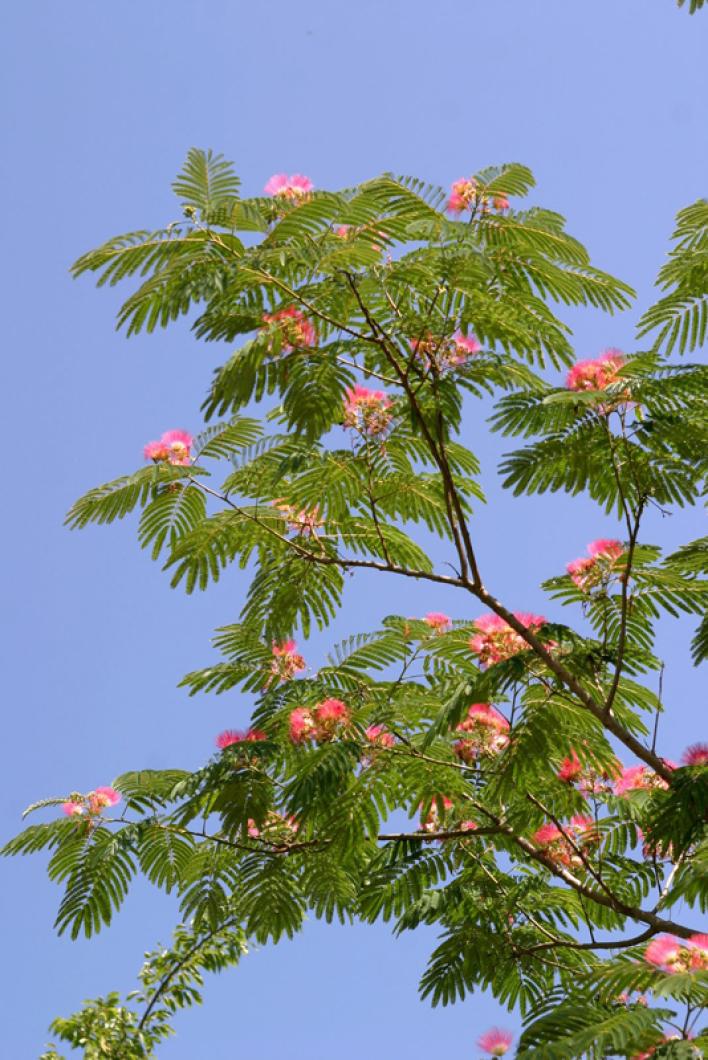Steve Bender, also known as the Grumpy Gardener, doesn’t mince words.
He is honest and forthright and speaks his mind. In his blog, posted June 29, 2009, he provides this advice to gardeners: “When anyone asks me what’s the best time to prune a mimosa, my instinctive response is, ‘Any time you can find a chainsaw.’”
Those are strong words for a strong plant that has become successfully entrenched in many lands.
Mimosa trees, also known as silk trees, pink siris, silky acacia, Persian silk tree, and Albizia julibrissin to scientists, are a hearty and prolific species. From humble Asian origins, this plant has become a traveler, eventually settling and becoming entrenched in countries worldwide.
Its pink puffball flowers and fern-like compound leaves have endeared it to many gardening greats and backyard botanists alike. Its scientific name honors an Italian nobleman who brought mimosa trees from Constantinople to Italy in 1793. A Frenchman bears the blame for bringing this tree to the United States.
Andre Michaeux brought the mimosa tree to his Charleston, S.C., garden and from there, as we now say, it went viral. It is present throughout the U.S. and continues to spread with assistance from animals and water dispersing its numerous seeds. A single mimosa tree can produce more than 200,000 seeds each year that are found in long-lasting pods which invariably litter the ground beneath the tree.
This plant is quite hardy and clearly has its enthusiasts and loathers.
We know where Steve Bender stands, but others don’t share his ire. Lady Ki, an 8th century Japanese poet, was inspired by the mimosa. Her poem from the Manyoshu Anthology describes the mimosa beautifully: “The silk tree blooms in the daytime, And sleeps the love-sleep at night.” This is a reference to what has been called the “sleep of the leaves,” the phenomenon of the tree’s leaflets folding together at night and then expanding slowly in the morning light.
The Chinese call the silk tree the “happiness tree,” and use its flower and bark to mend broken hearts and induce a feeling of contentment. Even now, some herbalists maintain that this plant can be used to treat depression, anxiety, insomnia, poor memory and irritability.
I fall in both camps: For me, the mimosa tree can both cause and cure irritability. The mimosa has a place in my memory and in my yard. As a child, I recall climbing the medium-sized tree to smell the fragrant silky flowers that appeared in the summer. This tree still elicits my affection, though as a native plant person, it also incites my indignation due to its propensity to prosper and spread.
So the heart and the head just can’t get together on this plant; which is why the Italian got credit for bringing it home, and the Frenchman got blamed for its introduction. And why some will toast the mimosa tree, while others encourage us to take a chainsaw to it. Both can be considered understandable reactions. As drinkers and botanists surely can agree, one mimosa may be delightful; however a lot of them can cause quite a headache.
Suzan Bellincampi is director of the Felix Neck Wildlife Sanctuary in Edgartown.




Comments
Comment policy »